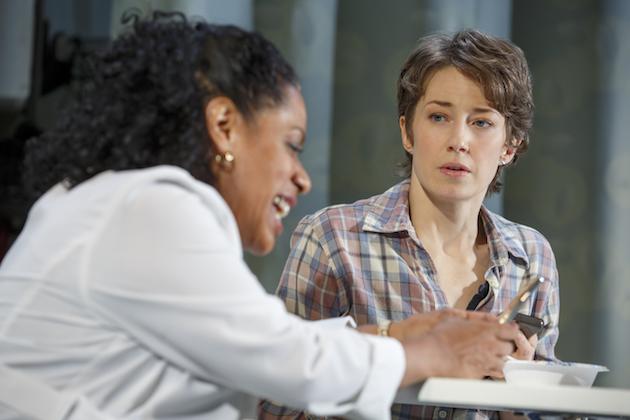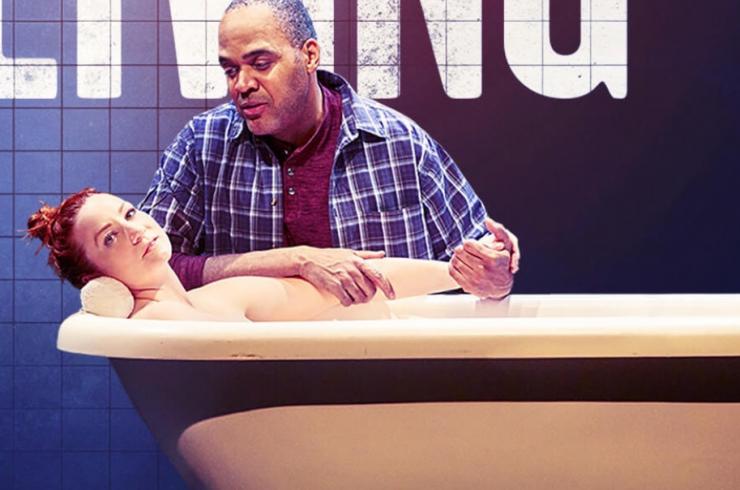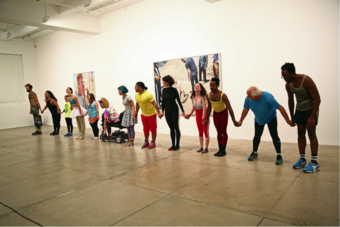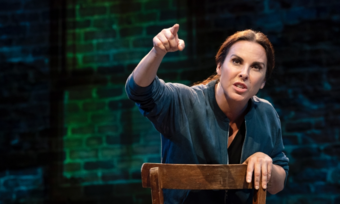Caregivers on Stage
Mary Jane, The Treasurer, The Cost of Living
In any given year, more than 65 million Americans—nearly one-third of the entire US population—are reported to be “informal caregivers,” the imprecise term for people who are taking care of a chronically ill, disabled, or aged family member or friend without being paid.
Several caregivers have been depicted on New York stages lately, in distinctly different plays that nevertheless share more than subject matter. Each is extraordinarily well-acted, surprisingly funny, deliberately inconclusive, resolutely unsentimental, but inescapably moving.

Mary Jane, a new play by Amy Herzog that opened late last month at the New York Theatre Workshop, is named after a single young mother (portrayed by Carrie Coon, 2017 Emmy nominee for Fargo and 2013 Tony nominee for Who’s Afraid of Virginia Woolf) who cares for her two-year-old toddler Alex. Alex was born prematurely and wasn’t expected to live more than a few days. He has cerebral palsy, and cannot speak or even lift his head.
While Mary Jane’s focus is on her child, the audience’s focus is on the title character. We never see Alex, and indeed aren’t even initially aware that he exists. As the play begins, Mary Jane is chatting with her building superintendent, Ruthie (Brenda Wehle), who’s trying to unclog a drain, until their conversation is interrupted by a monitor beeping offstage. Mary Jane disappears into the bedroom; we hear her working some kind of medical equipment; then she comes back and resumes her conversation.
In numerous such ways, the play presents two central facts about Mary Jane: Alex’s needs dominate and direct her day, and that she has accepted with equanimity that this is her life now. Indeed, in a pointed irony, Mary Jane’s conversation with Ruthie is cheerful—she tells a funny story about an encounter in the subway—while Ruthie’s is gloomy, she counters with a sad story about an accident in the subway.
This is more or less the dynamic with most of the one-on-one conversations Mary Jane has with a series of characters—casual conversations that form the core of the play. Mary Jane is consistently optimistic and outgoing, a good listener and attentive to the world around her. But there is no question she is also isolated from it. Taking care of Alex has taken a steep toll on her.
Mary Jane: I used to be someone who treasured sleep….but…
Ruthie: But you adjust.
We slowly learn what adjustments Mary Jane has made. She dropped out of school, giving up her plans to become a teacher, and has a menial job in order to have health insurance, a job she barely holds onto because of her numerous absences. She also suffers from migraines.
One senses that the crises we witness in Alex’s life are everyday occurrences for Mary Jane, and that little happens in her life that doesn’t involve just trying to get through the day managing Alex’s illness. This may help explain why there’s little sense of forward motion in Herzog’s play. It’s as if the playwright feels it would be dishonest to impose a plot on the day-to-day struggles of a caretaker whose life is nearly by definition repetitive and inconclusive.
One can speculate that Herzog is especially motivated to put a priority on verisimilitude over theatricality. She and her husband, director Sam Gold, are parents of a child born in 2012 with a debilitating muscle disease called nemaline myopathy.
On the other hand, unlike Amy Herzog, Mary Jane is the sole primary caregiver, because her husband abandoned the family. In keeping with her positive personality, Mary Jane is not bitter, telling a visitor: “He tried. He really did try. But he’s really...it’s hell for him, not being a part of Alex’s life. But he just can’t...I hope he finds some peace, I really do.”
It’s not just Mary Jane’s ex-husband who is out of the picture. There is no male presence in the play at all. The five members of the cast are women (as is director Anne Kauffman, the stage manager, and most of the designers).
The four other actresses each portray two characters, who (other than Ruthie) are either professional caregivers—hospital personnel, a home nurse—or strangers whom Mary Jane is meeting for the first time.
It feels as if Herzog through Chaya is making a statement about the general attitude toward caregiving in America…Caregiving is seen as women’s work, and women’s work is unnoticed and undervalued.
Susan Pourfar plays two very different mothers of chronically ill children. One, Brianne, for whom Mary Jane acts as a sort of mentor, overwhelming her with advice. The other, Chaya, an Orthodox Jew with six other children, who offers Mary Jane her condolences—“It’s terrible to do this by yourself”—and her wisdom: People say to Chaya that her disabled child is a blessing. “I think, right, the kind of blessing you don’t know anything about and you don’t want to know anything about.”
It feels as if Herzog through Chaya is making a statement about the general attitude toward caregiving in America. The commentary seems underscored by the female-only presence on stage. Caregiving is seen as women’s work, and women’s work is unnoticed and undervalued. It’s telling that, in this makeshift matriarchal culture within the larger and largely indifferent society, Mary Jane bonds easily and instantly with the two other mothers, and that she finds all the other women in the play supportive, whether their support is paid for or not.

Money is far more at the forefront of The Treasurer, a play by Max Posner and directed by David Cromer that opened at Playwrights Horizons a day after Mary Jane opened at New York Theater Workshop. Peter Friedman portrays a middle-aged man who, at the urging of his two brothers, takes responsibility for the finances of his recently widowed mother, Ida (Deanna Dunagan, who won a Tony for her role as Violet Weston in the Broadway production of August: Osage County).
The Treasurer (again, as the title implies) focuses on the son, rather than his mother (although the playwright gives her a name while keeping him nameless; he is referred to in the script and in the program simply as “The Son.”) The label “caregiver” doesn’t apply as readily with him as with Mary Jane, for many reasons. He doesn’t care for his mother—he doesn’t like her—calling her “impossible” and “beyond selfish” and telling us she “abandoned my father and me when I was thirteen…I raised myself.” He may have to agree to become her treasurer, but he doesn’t treasure her.
As an adult, he has always kept his distance from her, and he continues to do so when he takes on the task of her financial monitor, distant both emotionally and literally— he lives in Denver, she lives in Albany—and even theatrically—all but one of their conversations take place via telephone, with the two at opposite ends of the stage. (The Son is not close to his brothers either; they exist as disembodied voices portrayed by the two other cast members, Marinda Anderson and Pun Bandhu, who between them play a total of fourteen characters.) Laura Jellinek’s set design emphasizes this distance, and offers literal barriers to their communication (occasionally blocking the view for the audience as well).
Jellinek is also the set designer for Mary Jane, and it’s instructive to compare her two designs. The one for Mary Jane is more realistic and detailed; a far from luxurious one-bedroom apartment in Queens but one that feels lived-in. Small framed pictures and toys line the floor and sit on shelves; a (working) refrigerator is covered with magnets and pictures and doodads. Halfway through the play, the set is transformed (by automation and stagehands) into a hospital room, but that only emphasizes the warmth that Mary Jane establishes in her home and seems to bring as well even into the most sterile environment.
Jellinek’s sets in The Treasurer feel more coldly abstract and impermanent; one dividing wall dotted with small patches of white plaster even looks as if it’s under construction—unfinished just like the relationship between mother and son?
The Son talks often of hell—he tells us it’s hell for him to talk in front of people; he tells us that he is going to wind up in hell because “I don’t love my Mom”—and the set designer seems to be imagining a hell of the everyday.
The premise of The Treasurer—estranged parent and child—is certainly familiar. But unlike more conventional dramas, there is no arc towards reconciliation. If the mother stops spending recklessly, it’s not because The Son has been able to reach her (or rein her in), but because, in the grip of dementia, she starts to decline.
Playwright Posner lets us know unsubtly that The Treasurer is based on his father and grandmother (The Son tells us: “My son called this morning and asked if he could write a play about my mom…[a]nd….your relationship to her…”), and one might be tempted to conclude that the lack of reconciliation and resolution in the play is, as in Mary Jane, an effort to get at the everyday reality shorn of theatrical effect.
But in its last scene, The Treasurer swerves into full-force fantasy, exploring the unknown and the unknowable. It’s fascinating to realize that even this turn towards the cosmic has a parallel in Mary Jane; that play ends with the title character discussing spirituality with a Buddhist nun who works as a chaplain at the hospital.

Over the summer, the Manhattan Theatre Club produced Cost of Living, a play by Martyna Majok, directed by Jo Bonney, that tells two parallel stories of caregiving. John (Gregg Mozgala) is a handsome, wealthy graduate student in political science at Princeton University. He also (like Alex in Mary Jane) has cerebral palsy. He has advertised to hire somebody to take care of him, and when we first see him, he is interviewing Jess (Jolly Abraham), a recent graduate of Princeton herself, but also an impoverished first-generation American in desperate need of a job.
“I never worked with the…differently abled,” Jess says politely.
“Don’t call it that.” John replies. “It’s f…ing retarded.”
“So what do I… how do I…refer to you?” Jess stammers.
“Are you planning on talking about me?”
“No.”
“Why not? I’m very interesting.”
Majok is clearly not afraid to make her character both interesting and a bit of a jerk. This latter aspect of his personality becomes more pertinent once John hires Jess and a relationship develops, although not in the way that Jess (or surely the audience) comes to expect.
What was most compelling about the MTC production of Majok’s play were the scenes that showed us exactly what the caretaking entails—what it takes for Jess to give John a shower; how Eddie cheers Ani up in the bathtub by taking her paralyzed arm from the water and playing it like a piano…
The other story in Cost of Living involves Eddie (Victor Williams) and his wife Ani (Katy Sullivan) who shortly before became a quadriplegic as a result of a car accident. Eddie would like to be her caregiver, but Ani resists. They are estranged; not long before the accident, Eddie left Ani for another woman. But Eddie persists, and wears Ani down into accepting his care.
What was most compelling about the MTC production of Majok’s play were the scenes that showed us exactly what the caretaking entails—what it takes for Jess to give John a shower; how Eddie cheers Ani up in the bathtub by taking her paralyzed arm from the water, and playing it like a piano, synchronized with a radio broadcast of a piano concerto. It worked especially well because the two disabled characters were portrayed by actors who themselves have disabilities.
Like Jess with John, and unlike either Mary Jane or The Son, Eddie is getting paid for taking care of Ani, through their health insurance. But while that technically takes them out of the category of “informal caregiver,” Cost of Living is especially adept at helping us see how caregiver and cared-for are often engaged in a complex physical and emotional interdependence that sometimes seems indistinguishable from mutual dependence. As Carson McCullers wrote in her play The Square Root of Wonderful: “The closest thing to being cared for, is to care for someone else.”
Jonathan Mandell’s NewCrit piece usually appears the first Thursday of each month. See his previous pieces here.








Comments
The article is just the start of the conversation—we want to know what you think about this subject, too! HowlRound is a space for knowledge-sharing, and we welcome spirited, thoughtful, and on-topic dialogue. Find our full comments policy here